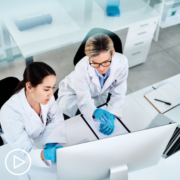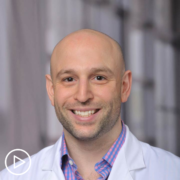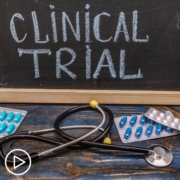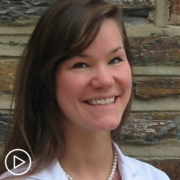Clinical Trials As a CLL Treatment Option: What You Should Know from Patient Empowerment Network on Vimeo.
Should you consider participating in a CLL clinical trial? In this webinar, Dr. Adam Kittai provides an overview of the clinical trial process and addresses common misconceptions. Dr. Kittai shares an update on the latest advances in CLL research and discusses key advice for patients considering trial participation.
Dr. Adam Kittai is a hematologist and an assistant professor at the The Ohio State University
Comprehensive Cancer Center – The James. Learn more about Dr. Kittai, here.
Download Guide
See More from CLL Clinical Trials 201
Related Resources:
Transcript:
Katherine:
Hello and welcome. I’m Katherine Banwell, your host for today’s program. Today we’re going to discuss the latest research advances in chronic lymphocytic leukemia and discuss the role of clinical trials in patient care. Before we meet our guest, let’s review a few important details. The reminder email you received about this program contains a link to program materials. If you haven’t already, click that link to access information to follow along during the webinar. At the end of this program, you’ll receive a link a link to a program survey. This will allow you to provide feedback about your experience today and it will help us plan future webinars.
Finally, before we get into the discussion, please remember that this program is not a substitute for seeking medical advice. Please refer to your health care team about what might be best for you. Okay, let’s meet our guest today. Joining me is Dr. Adam Kittai. Doctor, welcome. Would you please introduce yourself?
Dr. Kittai:
Thanks for having me. My name is Dr. Kittai, I’m an Assistant Professor at the Ohio State University, and I specialize in research and clinical research in Chronic Lymphocytic Leukemia.
Katherine:
Great. Thank you so much for taking the time to join us today.
Dr. Kittai:
Happy to be here.
Katherine:
I understand that CLL researchers met recently at the annual American Society of Clinical Oncology meeting, also known as ASCO, to share their research. Are there highlights from the meeting that patients should know about?
Dr. Kittai:
Yeah, so this time of year, there are two main conferences actually that are very important to the CLL groups at large, as well as the oncology community. So, there’s ASCO and then there’s EHA, the European Hematology Association. And in general, there was a lot of exciting things at both of these conferences.
In CLL, we have two main treatments that we’re really focused on. One is called the BTK inhibitors, which is ibrutinib, acalabrutinib, and zanubrutinib that you may have heard about. And the other treatment regimen is called venetoclax, and that’s usually paired with something called obinutuzumab. So, right now we’re either using the BTK inhibitors or the venetoclax as our frontline therapies. And typically, when patients progress on either one of those treatments – their disease gets worse – we switch to the other one.
And so, what I’m getting to be that right now, that paradigm of starting with one therapy – the BTK inhibitors or the venetoclax – and then switching to the other, or vice versa, is being challenged. How that’s being challenged is combining the two medications together to see if combining them together is better than giving them sequentially. So, I think this is the primary research that’s being looked at in the world of CLL and we got some updates to show that the combination of the BTK inhibitors, plus the venetoclax, is looking quite good. It’s looking like it’s inducing deep remissions in some of our patients.
Some of the challenges here though that we still need to figure out is that a lot of these combinations are leading to more toxicity. So, ultimately, I think we’re going to have a discussion about who is the appropriate patient for the combination, as opposed to giving it sequentially.
There’s also a lot more research going on, looking at what we call randomized trials, which we’ll get to in a second, to determine if the combination is better than giving it sequentially. Right now, we just have what we call single-arm studies that kind of show safety and how well the trial works. But really, the definitive clinical trials – and once again, we’ll get to this a little bit later – are going to be randomized study where we randomize patients to the combination versus the sequential therapy to determine if doing it together is better than doing it sequentially.
So, I would say that this new treatment paradigm of combining our two main treatments up front is looking quite good. We’re worried about some of the toxicities when we combine these medications, and we’re still not quite sure if combining them is the right approach, if it actually is superior to giving them sequentially. So, I think that’s the name in research right now for CLL, whether or not combination therapy is better than sequential therapy. The jury is still out, but some of the new data we saw was exciting.
Katherine:
So, how can patients stay up to date on research like this as it develops?
Dr. Kittai:
Yeah, great question. So, for one, you can talk to your physician. A lot of the physicians will go to either ASCO or the European Hematology Association and be able to come back with some of this data to share with their patients. And then also, there’s a lot of smaller conferences that local oncologists will go to get highlights from these particular conferences, where they also will come back to the patient to let them know some of this highlighted research. I think that’s probably the easiest way for patients to get access to this research. And Google’s our friend, right? And so, a lot of things are available on Google if you know where to look for them.
Katherine:
Right. So, a key part in moving forward with CLL research is clinical trials, right? So, for people who may not know the term, what is a clinical trial?
Dr. Kittai:
Yeah. So, a clinical trial is an experiment where patients are enrolled to receive a treatment that is either new or new in a new setting – so, an old treatment in a new setting – and we’re looking to see whether or not the treatment leads to improved outcomes for our patients.
Katherine:
Why would a CLL patient consider participating in a trial? What’s the benefit for them?
Dr. Kittai:
Yeah, great question again. The benefit of a clinical trial is two-fold. One is that by participating in a clinical trial, we are collecting data to determine what’s best for patients moving forward. [00:07:06] So, in a way, by participating in a trial, you’re contributing to the benefit of CLL patients in the future to help us determine what’s best for everybody moving forward. That’s one reason to go on a clinical trial. Another reason to go onto clinical trials is that it allows for access to therapies that may not be available otherwise, which may work better than what we already have and may be safer.
Katherine:
Right. So, I’d like to walk through a few common questions that patients have about clinical trials. And here’s a concern we received from a patient prior to the webinar. “I’m nervous that I will receive a placebo if I join a clinical trial.” So, first of all, would you define a placebo?
Dr. Kittai:
Sure. A placebo is usually a sugar pill or something that has no effect. That’s what a placebo is.
Katherine:
And is it true then, would a patient possibly get a placebo in a CLL clinical trial?
Dr. Kittai:
Not typically. So, in terms of clinical trials for CLL, we have a lot of treatments that are effective and safe in CLL. And so, we don’t typically design trials where you’re not getting some kind of active therapy. It would be extremely rare, and I don’t know of any trials currently that involve patients getting a placebo for CLL. Because it wouldn’t be ethical for us to enroll a patient on a trial where they would get a placebo instead of active therapy.
Katherine:
Right. That makes sense. Here’s another question from an audience member, and I think this is probably a common concern for patients. “Is a clinical trial only something I should consider if there are no other options?”
Dr. Kittai:
So, in my opinion, you should always consider a clinical trial, even if there are other options. And it’s because of those two reasons that I mentioned earlier. Number one, it benefits the CLL community as a whole to participate in the trial so that way doctors and researchers can collect data to improve outcomes for patients with CLL. And also, even though our drugs currently work really well, we don’t know how well they’ll last for, right? So, they still don’t know for certain how long our current drugs are going to work for in the future.
And we’re always trying to do better. We’re always trying to create some sort of treatment, some sort of treatment paradigm that might be safer, as well as work better, and either of those goals is approvable. All of our drugs come with toxicity, right? And even though they’re really safe and they work really well, we’re hoping to develop something that is even safer and works even better.
Katherine:
Yeah. It sounds, then, like trials can be considered throughout a patient’s life with CLL. What concerns do you hear from your patients?
Dr. Kittai:
Yeah, so I think the primary concern I hear about a trial and the difference between going on a trial and standard of care, is that typically for a trial, it does require a little bit more from the patient. Meaning that there’s usually more visits – whether it is to monitor the effect of the new medication or new medication combination on the patient, whether or not it’s affecting their laboratory values or how they’re feeling.
Or there might be parts of the trial that require invasive procedures. So, for instance, many trials will require bone marrow biopsies where a standard of care won’t. And the reason why the collection of those bone marrow biopsies is important for the trial is to better get an idea of how the treatment is working on a patient’s body.
So, I think those are the two primary concerns I hear from the patient. Number one, it typically is a bigger time commitment with more visits to the doctor because we have to closely monitor the patients while they’re on trial. And number two is sometimes the trial involves procedures that otherwise wouldn’t be indicated for standard of care.
Katherine:
Let’s talk a bit about how trials work, starting with the phases. What happens at each phase?
Dr. Kittai:
There are actually four phases of clinical trials, although three phases are typically what’s talked about. So, Phase I is when we are first introducing the new medication, the combination, or the old medication in a new scenario for the first time in a human being.
Phase one encompasses a lot of different things. It could be a first in-human phase one, where we’re giving the drug for the first time in a human being. It could be, as I said, the combination of drugs being used for the first time in a human being. Or it could be that we have this drug that works for this other cancer and we’re trying it out on this new cancer. So, we might have experience with this drug in another scenario, but not in the scenario we’re trying to do.
And the primary purpose of the phase one clinical trial is to see if it’s safe. So, that’s the primary purpose of a phase one clinical trial – see if this new medication, this old medication in this new scenario, or this new combination is safe to use going forward.
Katherine:
Right.
Dr. Kittai:
We are able to see if it works to a small degree in the phase one trial, but typically these trials are very small with somewhere between 10 to 50 patients. And so, it’s hard to know how well this works by looking at such a small amount of patients.
Once the Phase I trial goes forward, we usually go onto Phase II. So, one of the other points about Phase I is to determine the correct dose. Usually in phase ones, we increase the dose of the drug slowly until it meets some sort of toxicity cut-off for our patients. So, once that dose is discovered, then we move onto Phase II, and Phase II is usually a small study, usually about 50-100 patients where we’re looking at preliminary efficacy, to see if this drug, this new combination, or the drug in a new scenario, is actually working.
And so, Phase II will tell us we think it’s working and if it looks good in phase two, it gets moved onto Phase III. Phase III is the final part of the drug development, where if it passes Phase III, it usually gets approved by the Federal Drug Administration. And Phase III is usually a randomized trial where you’re giving the new drug, the combo, or the old drug in a new situation, and you’re comparing it to whatever’s used as standard of care in that particular scenario.
Katherine:
Right.
Dr. Kittai:
And that’s usually a randomized study where patients are either getting the new thing or the old thing. And then, we’re determining which one works better. Lastly is Phase IV, and this is post marketing. So, after a drug gets approved, the drug company and the FDA requires just a wide scope of just data that’s collected to see how well the drug is working and if it’s safe once it’s brought out to the wider community.
Katherine:
Okay. You mentioned randomized clinical trials. There are a couple of other clinical trials as well. Would you define them and tell us how they’re different from one another?
Dr. Kittai:
Yeah. So, a randomized trial is when you enroll onto a study, and you get randomly assigned to either the experimental arm or the control arm. The experimental arm is that new drug that we talked about. And the control arm is usually the standard of care. So, that’s a randomized study.
And randomized studies are usually Phase III trials, but they can be phase two in some scenarios as well. You have – usually that’s paired with a randomized control study. So, a control study is just there’s a control arm, that’s what that means. But those usually go hand in hand. Those are usually together.
And then another trial is the double-blind clinical trial. So, a double-blind clinical trial means that once you’re randomized to either the experimental or the control, neither you nor the physician know what drug you’re taking. And that usually is not used in CLL trials. Usually, we know what drug the patient is assigned to. And the reason why that is, is because oftentimes we’re looking out for specific adverse events or toxicities of the drugs we’re implementing at Phase III.
And then, also, if you’re getting a triplet versus a doublet, meaning three drugs versus two drugs, it’s very hard to blind somebody to know which drug they’re on because obviously you’re getting three drugs versus two drugs. Or if an infusion is involved in one arm but not in the other arm, you obviously know that you’re getting an infusion versus an oral drug.
Katherine:
Ah, okay. Are there common clinical trial terms that you think patients should know about?
Dr. Kittai:
I think we covered most of them. So, knowing that phase one is typically the first in the sequence of events that I would ask your physician if this was a first in human study, right, because that comes with some special considerations knowing that you are the first human to receive a new drug is very important. Versus a phase three study where, you know, you know this drug has already gone through phase one and two in development, meaning it’s been given to a lot of patients, and they’re just looking to see if it’s better than standard of care. So, I think knowing those general concepts about what’s the difference between a phase one and a Phase III study, it’s very different. I think it’s important to keep those in mind when talking about clinical trials and discussing with your doctor.
Katherine:
Patients often have questions about safety. What are the risks of clinical trial participation?
Dr. Kittai:
Yeah, so before anybody enrolls onto a clinical trial, you should sit with your doctor to talk about the pros and cons of entering this clinical trial. One of the things that they will talk to you about is what the expected safety of this drug is. So, you might ask yourself, well, if it’s a phase one study, first in human study, how do they know what toxicity to expect?
Katherine:
Right.
Dr. Kittai:
The answer is that there’s a lot of pre-human studies that occur, both in mice and monkeys and other animals, and researchers often have a good idea of what to expect in human. But there is a lot of unknowns in a phase one clinical trial. And after discussing with your doctor the pros and cons of going on a clinical trial and what side effect profile to expect from whatever drug or combination that you are about to be using, usually you go through a consent.
Usually, you’ll get a packet, it’s about 10 to 20 pages long, written in a way that patients can understand. And it’ll have a list of toxicities that are associated with the research that is occurring. In terms of knowing what adverse events might happen, the consent is key, because it’ll have those all listed out.
And also having the conversation with your physician about either what they’ve experienced giving this clinical trial, or what is to be expected after this drug had been introduced pre-humans.
Katherine:
Mm-hmm. Are there protocols in place to protect patients?
Dr. Kittai:
Yes. So, remember how we talked about in the phase one trials, we dose escalate the drug until we’ve reached some toxicity limit? There are specifically rules written out in a protocol that the doctor must follow that ensures safety for the patients that enroll in clinical trials. And that dose escalation part where we reach a toxic limit is a key part of those phase one trials that is spelled out before you even enroll.
Usually, there’s also something called a Data Safety Monitoring Committee, as well as other committees that are looking at patients as they are receiving these drugs and move forward on clinical trials to make sure that the investigators are following the protocol as printed. That if anything happens, they document why it happened and fix the problem before it becomes another problem for a patient. So, there are very specific safety rules and a lot of redundancy to protect our patients, because the number one priority is to protect the patient.
Katherine:
Yeah. I think you’ve already answered this, Dr. Kittai, but how do you know the medicine is safe before a human trial even begins?
Dr. Kittai:
The answer is you don’t. There is some risk. As I said, they do test it in animals before they give the drug to humans, and they usually start at the lowest dose possible. But there are certain circumstances where there are surprising side effects that are not expected. And so, when you’re entering a first in human, Phase I trial, that is a specific risk that you do need discussed with your physician about before you enroll.
Katherine:
Can a patient change their mind once they’ve enrolled in a clinical trial?
Dr. Kittai:
Always. Always.
Katherine:
Okay.
Dr. Kittai:
They can come off the clinical trial at any point if they choose to.
Katherine:
Okay. Now that we know what trials are and how they work, how can people find out what trials are available to them?
Dr. Kittai:
Yeah. So, I’ll come back to this, but once again, talk to your physician. They’ll know what clinical trials are available at whatever site you are seeing them in. If there’s a local academic sector, the academic sector typically has clinical trials available there as well. So, it’s always good to get a second opinion in that regard.
But one of the open access places that you can find all clinical trials is clinicaltrials.gov. This has all active running clinical trials listed out and anyone can access it. There are other societies out there that often post about clinical trials. So, there’s the CLL Society. It’s a website that you can check out that has a lot of information on there about active clinical trials in CLL. There’s also The Leukemia & Lymphoma Society, the Lymphoma Research Foundation, they all have websites available that have a lot of clinical trials listed and how to access them.
Katherine:
Are there key questions that you think patients should ask their health care team about participating in a trial?
Dr. Kittai:
Yeah, for sure. I think one of the key questions to ask is, is the control arm appropriate. So, what do I mean by that? Sometimes people who design a clinical trial will design a trial where the control arm is an easy control arm to beat, meaning that it’s a treatment that we wouldn’t necessarily put you on as standard of care.
And so, I think this is a real question and an honest question that you should ask your physician prior to enrolling on a trial is, is the control arm something you would give me as standard of care. And if the answer is no, you should really consider not going on that trial or talking about why you would want to go on that trial if the control arm is not something they would put you put you on as standard of care.
Katherine:
Right.
Dr. Kittai:
That’s, I think, a key question to ask. And again, asking what phase it is and understanding where we are in the development.
Katherine:
What do you feel are the barriers to accessing clinical trials for patients?
Dr. Kittai:
So, unfortunately, a lot of clinical trials are at academic centers, and so there are – and the reason that is, is that the academic centers have the infrastructure to run the clinical trial. So, as we have mentioned before, there’s a lot of visits with a lot of extra science and labs that are done associated with the clinical trial. And a lot of those things and the coordination can only be done at large centers that can open clinical trials and know how to run them.
Similar explanation could be that that safety monitoring committee that I’d mentioned before, where the academic centers have the infrastructure to ensure safety for the patients. So, access to academic centers is a limitation to enrolling in clinical trials. That being said, there are a lot of centers that are associated with an academic center and do have a lot of the clinical trials that are available at the academic center.
And there are also cooperative groups. These cooperative groups are called Alliance and ECOG and SWOG. And these cooperative groups are national groups that are headed by multiple academic centers in partnership with pharmaceutical companies and they typically run large Phase III medical trials that help redefine standard of care. And those particular clinical trials are often available at private practices as well.
Katherine:
Oh, that’s great. So, patients don’t necessarily have to think about traveling to a large educational institution then to become part of the clinical trial?
Dr. Kittai:
Not always. Not always. Typically for the Phase I, the answer is yes. But for Phase III trials, usually there’s a lot of access available for Phase III trials.
Katherine:
What would you say to patients who may be hesitant about participating in a trial?
Dr. Kittai:
I would say that it’s important to at least ask about what’s available. And knowing what’s available and the risks and benefits of going on a clinical trial is how you should make the determination if you should go on a clinical trial.
Remember what I said earlier that the clinical trial is really meant to help improve safety or efficacy. So, we don’t open clinical trials that we are not hoping to improve one of those two things. And so, that is something that we should be able to put in words to you when inquiring about the clinical trial. What is the goal of this trial, and why do you think it’s going to improve safety or efficacy? And the physician who’s talking the trial with you about it should be able to answer those questions for you. So, if you have some hesitance about going in clinical trials, I would say gather your information first before making a final decision.
Katherine:
Some patients worry about the financial aspect or impact of a clinical trial. Aren’t trials expensive?
Dr. Kittai:
So, actually, most clinical trials are less expensive than enrolling a standard of care. So, this is actually a benefit of going on a clinical trial. Often times, the drugs in the clinical trial are a cover. So, that’s something to ask too. And so, if somebody’s having trouble getting access to novel therapy that is looking good in a specific cancer, a clinical trial is actually a way to get access to that drug without paying for it.
Also, all clinical trials when they’re being developed are looked at by the finance committees of the hospital or wherever it’s being developed. All standard of care options are billed through the patient insurance, but all the extra stuff is usually covered by the pharmaceutical company that’s enrolling those patients onto the trial. Or I should say the supporting the clinical trial, excuse me.
Katherine:
That’s really good information to have.
We touched on research at the top of the program, but are there other areas of research that you’re excited about and that patients should know about?
Dr. Kittai:
Yeah, so one of the things that I think is being really talked about in cancer care – and medical care in general – is if disparities exist between minority patients and white patients. And I think this is a really, really important topic.
So, the American Society of Clinical Oncology, which had the conference recently, really made this a mainstay point of the conference this year and there were a lot of abstracts that were defining whether disparities exist and hopefully, by defining whether disparities exist, we’re able to target those disparities in order to make outcomes equal for all of our patients.
So, in the CLL world, one of the things that I alluded to is a lot of our therapies can be really expensive. So, these new therapies are really expensive, they really widen the disparity gap for patients who are minorities, as well as patients who come from socioeconomic status.
Katherine:
Absolutely.
Dr. Kittai:
And so, there were two abstracts. One was an oral presentation that looked at the National Cancer Database in ASCO that showed that Black patients do have worse overall survival than white patients. And then, I actually did my own study looking at the SEER database, which also showed the same exact thing. Even when controlling for socioeconomic status.
So, I think addressing these disparities, making sure that there’s equity amongst our patients, that everyone has access to these drugs and can afford them, especially when they make our patients live longer and are safer than chemoimmunotherapy in CLL is very, very important.
Katherine:
Dr. Kittai, if a patient feels like they’re not getting equitable care, are there resources available for them?
Dr. Kittai:
Yeah, so one of the things that I love about the CLL society, is that they have a section called Access an Expert, I believe. So, look on the website, I’m not sure it’s actually called Access an Expert, but it’s a way for all patients to get a second opinion from one of the CLL experts listed on the website. And so, if somebody is feeling like they’re not getting access to the most beneficial treatment, for whatever reason, seeking a second opinion and using the CLL Society’s website to find that second opinion, I think would be a great way for someone who feels that way to get access to the care that they deserve.
I believe there are other ways to do this through the Lymphoma Research Foundation, as well as LLS. But I know for sure on the CLL Society, there is a link that you can click that you can get access to a second opinion.
Katherine:
Yeah. I’m glad you brought that up. As we wrap up the program, Dr. Kittai, I’d like to get your final thoughts. What message do you want to leave the audience with related to clinical trial participation?
Dr. Kittai:
Yeah. So, I would say that in the last ten years, there’s been a revolution in the way we treat CLL, and we wouldn’t have gotten here without clinical trials. So, the reason why we have the BTK inhibitors – the ibrutinib, acalabrutinib, and zanubrutinib – and the reason why we have the BCL-2 Inhibitor venetoclax, and the reason why these have changed the way that we treat CLL making our patients live longer with better safety profiles is because of clinical trials. And so, I am a firm believer that if we can enroll a patient onto a clinical trial that’s appropriate, who might benefit from the trial, then they should enroll in the clinical trial if possible.
So, I strongly encourage everybody to enroll onto clinical trials, to get access to, you know, groundbreaking new therapies. And once again, I want to highlight that the point of a clinical trial is to improve safety or to improve efficacy and that’s why we develop clinical trials and that’s the hope by running it.
Katherine:
Okay, that’s great advice. Dr. Kittai, thank you so much for joining us today. It’s been a pleasure.
Dr. Kittai:
Yeah, it’s been a pleasure to you. Happy to be here.
Katherine:
Thank you.
And thank you to all of our partners. If you would like to watch this webinar again, there will be a replay available soon. You’ll receive an email when it’s ready. And don’t forget to take the survey immediately following this webinar. It will help us as we plan programs in the future.
To learn more about CLL and to access tools to help you become a proactive patient, visit powerfulpatients.org. I’m Katherine Banwell. Thanks for being with us today.












